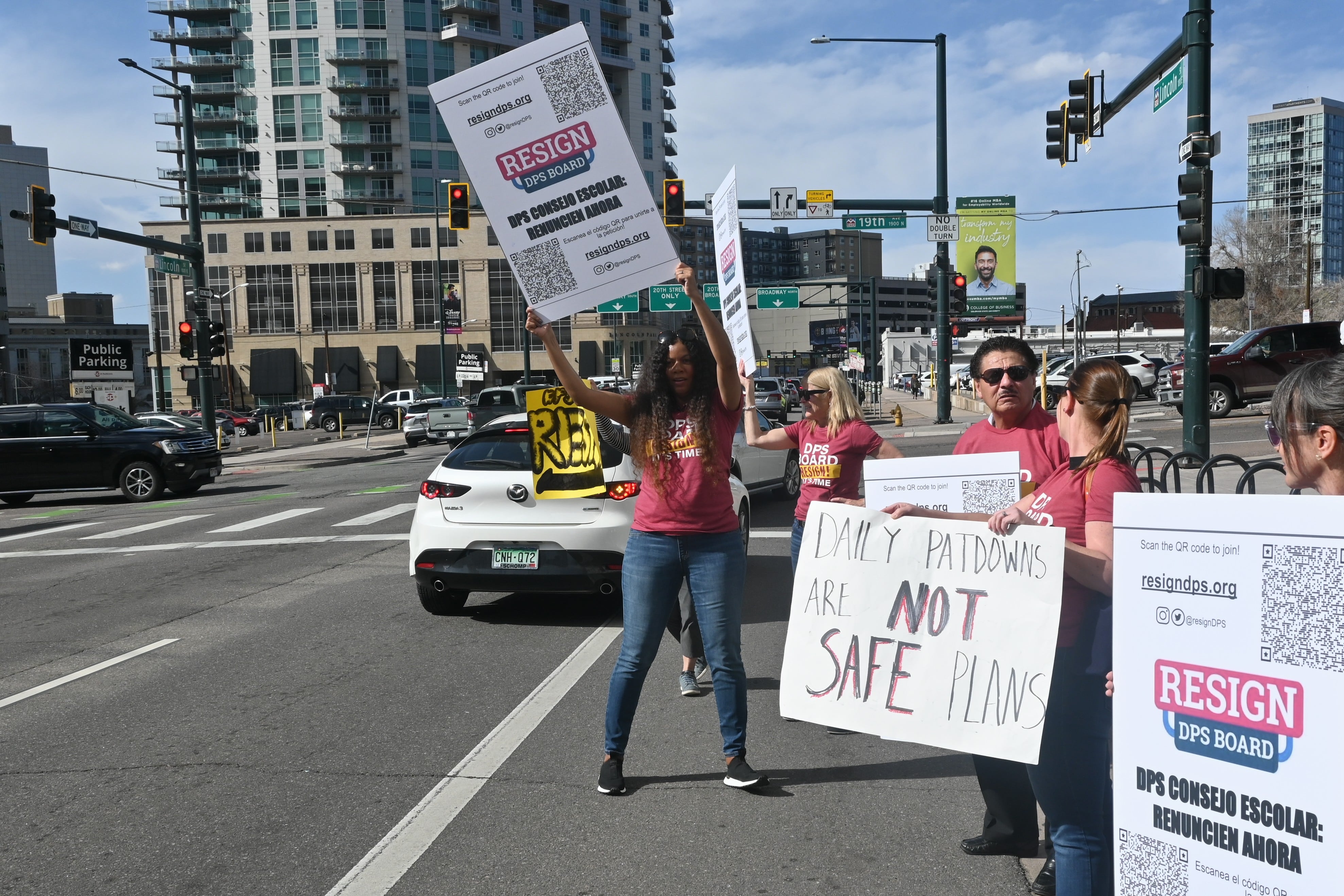Amid calls for more transparency and accountability, Denver Superintendent Alex Marrero promised that educators, students, and community members will have the chance to weigh in on two draft versions of a new safety plan before a final version is released on June 26.
Marrero detailed the timeline for the plan during a Monday board meeting — the same night a few dozen protesters outside called for board members to resign for failing to keep students safe. They cited the recent East High shootings and other incidents of violence.
Many of the parents wore maroon shirts that read “DPS Board Resign!”
“We need a fresh start,” Becky Nemec, a parent of two Denver school children, told the board. “But while we wait to have the opportunity to vote you out of office, I beg you to listen to the concerned students and parents.”
Other parents and students also called for the board and Marrero to work collaboratively, urgently, and transparently to fix safety issues.
Megan Zeiger, a Denver parent, said parents want the school district to work better with families and are ready to help.
She said parents have been concerned for a long time, “but with the recent events of East High School, we no longer feel we can rely on other people to figure out how to solve this problem.”
Each call for the board to resign was met with audience applause.
The board tasked Marrero with coming up with a way to improve safety a day after the March 22 East High shooting that injured two administrators. Since the board lifted its ban on police officers in schools, the district has posted 14 officers at 13 schools, including two at East High.
Parents asked the board why it didn’t act after the killing of student Luis Garcia outside the East High in February. Others said the district’s policies have kept too many students with violent histories in schools that aren’t equipped to help them.
For instance, some parents pointed to a recent incident at McAuliffe Middle School where the district allowed a student who had been charged with attempted murder to stay in school over the objections of the principal.
At a press conference earlier Monday held by Parents-Safety Advisory Group, Nemec told reporters she was startled to learn that her children are attending McAuliffe with a student who had been accused of a serious violent crime.
She said her son describes students cussing out teachers and vaping throughout the school day without consequences because teachers don’t feel they have the tools to discipline them.
“We’ve really handcuffed our teachers and our principals from being able to address those problems in school,” she said. “And it becomes kind of a culture, and then all of a sudden, it kind of breeds itself.”
Marrero said he will draft a safety plan by May 1 with input from safety and security experts, students and community members.
Marrero last week had seemed to downplay the importance of community input, telling board members that “there’s been a request for a community-led process. And I want to say this very carefully and respectfully: “This is where we need the experts, first and foremost.”
On Monday, he said there would be community input throughout the process but wanted experts to weigh in on current and future issues the district could face. He said he would consider including more student representation after board Vice President Auon’tai Anderson questioned whether one student could represent the entire district of 87,000 students.
Board members also wanted to ensure the district hears from Black and Latino communities most affected by gun violence.
The district will hold virtual and phone-in town hall meetings to gather input on Marrero’s draft. He plans to release a second version by May 26 and a final version a month later.
The board and Marrero have come under increased scrutiny for their actions.
Some parents have said the district isn’t acting transparently and communicating well with families. Some people objected to the board retreating to a five-hour closed session when it decided to add school resource officers back to school.
Axios reported that Denver City Council members were frustrated that Marrero skipped a meeting Monday with council members to discuss cooperation between the district and the city. Instead, he sent staff members.
Many parents said Monday they’re fed up.
East parent Dorian Warren said the board has focused more on its own spats than on keeping students safe. She said the board needs “some adults in the room,” who can focus on creating policies that benefit students. She said the board has failed.
Bruce Randolph School student Angela Hurtado, 16, said she’s felt scared too many times at school and her family has worried too much. Parents shouldn’t have to bury their children, she said.
“The only time parents should cry is at their graduation, and not at their funeral,” Hurtado said.
Jason Gonzales is a reporter covering higher education and the Colorado legislature. Chalkbeat Colorado partners with Open Campus on higher education coverage. Contact Jason at jgonzales@chalkbeat.org.





